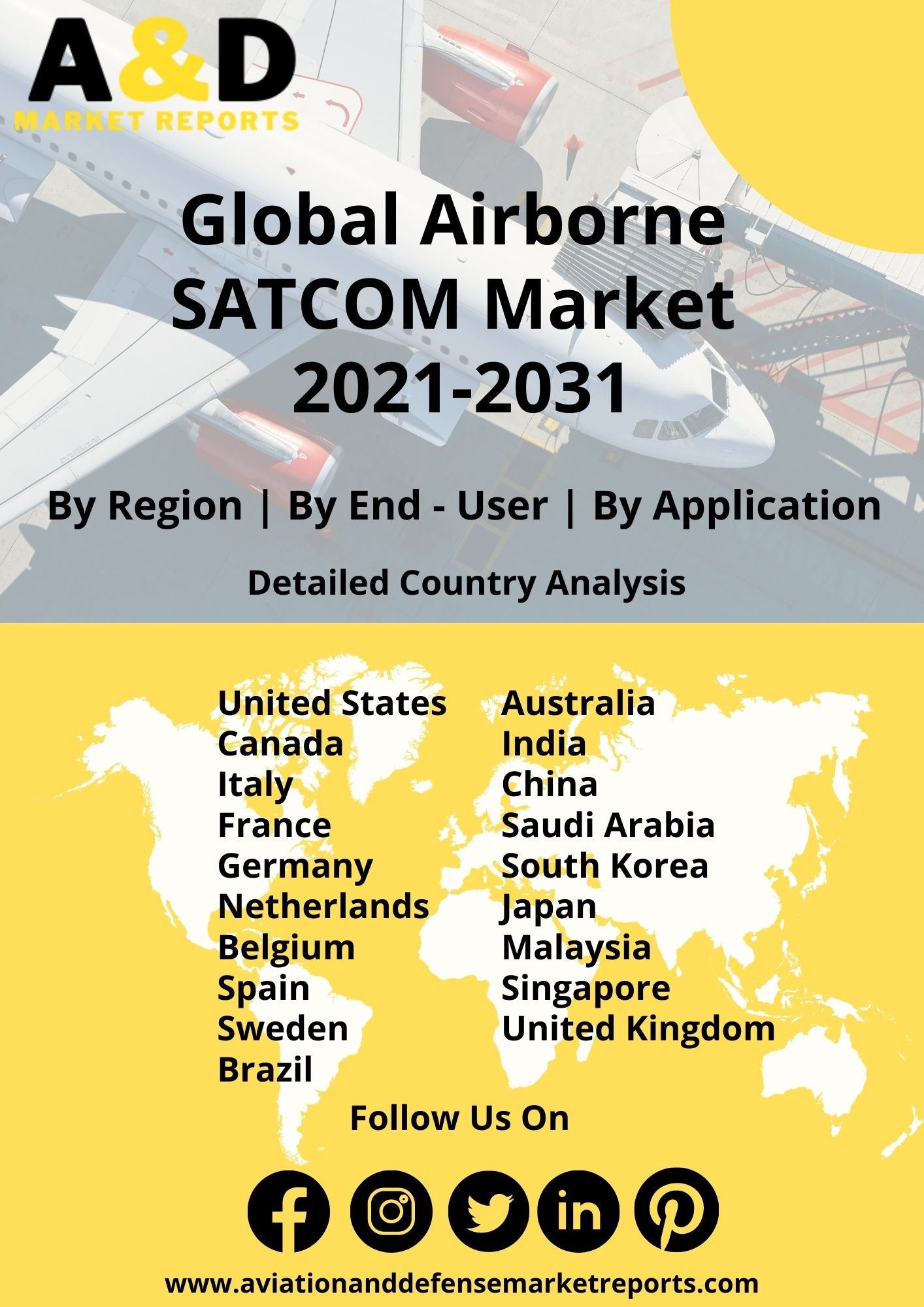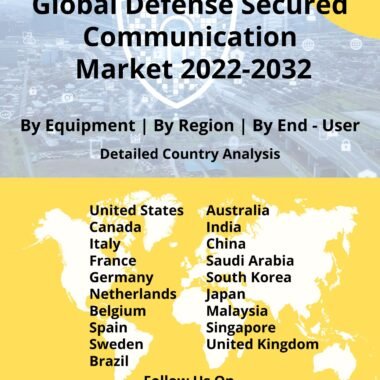Description
Global Airborne SATCOM Market
Frequently Asked Questions of Airborne SATCOM Market
As the military evolves into a force centered on sophisticated platforms with high bandwidth needs used to support networked operations at greater distances, satellite communications will become an increasingly important capability. In conclusion, the utilization of space has increasingly become a necessary prerequisite for many other types of contingencies, particularly those at the upper end of the war-fighting spectrum. Complete resilience against a broad range of changing counter-space threats, taking into account the emerging realities of space as a contested battlefield. This entails creating a airborne satcom market satellite constellation in space that is optimized to withstand anti-satellite operations that may use a variety of direct-ascent missiles, electronic warfare (jamming), and co-orbital anti-satellite operations.
Airborne SATCOM Market is important for communications networks as military forces increasingly rely on space-based assets to complete their missions, thus increasing the Airborne SATCOM market size. This ensures that users are always connected and prepared for the growing amount of data that will be collected and disseminated on the ground, in the air, and in orbit. Airborne SATCOM market size allows an expanded picture for decision-making and an unbroken flow of data. ISR (Intelligence, Surveillance, and Reconnaissance) footage from military aircraft can be streamed in high definition to troops on the ground or at other command centers. To keep everyone informed and prepared for action, airborne command and control and tactical communications are used, such as transmitting real-time information to troops above drop zones and in enemy sites. Through videoconferencing, phone, and data communication, commanders in flight can undertake mission planning and will always be aware of what is happening, ready to carry out strategic decisions at a moment’s notice.
Major factors driving Airborne SATCOM Market Growth
Proliferation of UAVs will be one of the primary drivers for the airborne SATCOM market growth. As drones continue to replace manned platforms, the airborne SATCOM market growth will continue to increase. The airborne SATCOM market forecast the increasing demand for net-centric warfare capability will also drive the growth of airborne satellite communications market.
Trends influencing the Airborne-SATCOM Market Size
One of the most difficult problems with airborne COTM is providing high-speed communication through small mobile antennas. Low gain characteristics are a need for COTM sub-one meter antennas. To ensure that the receiving terminal can hear the remote above the background noise emitted when the satellite amplifies the signal, more power is needed. Small antennas used to transmit these high-rate messages sometimes interfere with nearby satellites that may be operating at the same frequency and polarization. Proliferation of UAV systems will significantly influence the growth of the market.
Airborne-SATCOM Market Forecast & Dynamics
Airborne SATCOM market trends Increasing need for low-latency airborne SATCOM will continue to drive the market. Increasing defense spending will drive the market for new procurement activities and upgrades to existing platforms with newer technologies and airborne SATCOM market trends. Demand for persistent and resilient SATCOM systems will continue to be a significant driver for the airborne SATCOM market.
Airborne SATCOM Market Analysis for Recent Developments
Airborne SATCOM market reports, Get SAT Acquires Multi-Million Dollar Contract with US Government. Get SAT, a pioneer in lightweight satellite communication terminals for ground, airborne, and maritime applications, today announced that, in collaboration with R4 Integration, the leading supplier of airborne roll-on/roll-off communication systems for U.S. and partner government aircraft, it has received a multi-million dollar contract from a U.S. Government agency to provide satellite communication for C-130 aircraft. Airborne SATCOM market reports, Airborne ISR Satcom Services Contract for $52 Million Awarded to ViaSat. Utilizing Ku- and Ka-band satcom communications, typical operational data rates of the aircraft vary from 1 to 8 Mbps. These systems have flown over 500,000 mission hours on over 300 government aircraft, including the C-130, C-17, U-28, and different King Air variants.
Airborne SATCOM market analysis, the French Defense Purchasing Agency (DGA) has given Thales and its partners the 17-year MELISSA2 contract for the development, integration, and support of aircraft Satcom stations as part of France’s SYRACUSE IV military satellite telephony programme. Thales will deliver a robust, high-data-rate satellite station capable of connecting substantial military aircraft in all situations to satisfy the French Air and Space Force’s connectivity requirements as high-intensity conflict reemerges. The Thales terminal is based on a sitcom device that has completed over 30,000 commercial flight hours. The militarized version is specially made to stay connected to command centers when operating in congested areas and under adverse flying and weather circumstances.
Airborne SATCOM market analysis, as part of the Navy’s Take Charge and Move Out (TACAMO) Weapons System, Collins Aerospace has been given the contract to create a Very Low Frequency (VLF) communication system for the E-6B Recapitalization Program (E-XX). For the upgrading of the aerial VLF system in support of the capabilities needed by the Airborne Strategic Command, Control, and Communications Program Office (PMA-271), the contract offers developmental design and risk reduction engineering work. The system that was created as a result of the development work has improved security features to handle advanced and new threats. In order to comply with SWaP-C standards for VLF system integration into a C-130J-30 aircraft as part of initial platform testing, this risk reduction effort is being made.
The market is soaring to new heights, playing a pivotal role in modernizing and enhancing the connectivity of airborne platforms across the aerospace and defense sectors. Airborne SATCOM systems facilitate secure and high-speed communication for a variety of applications, including intelligence, surveillance, reconnaissance (ISR), command and control, and in-flight connectivity for commercial aviation. The market is experiencing substantial growth driven by the increasing demand for real-time data transfer, mission-critical communication, and enhanced situational awareness in airborne operations. Advancements in satellite technology, phased-array antennas, and bandwidth optimization contribute to the efficiency and reliability of Airborne SATCOM systems.
Technological innovations within the Airborne SATCOM market include the development of High Throughput Satellites (HTS), Ka-band and Ku-band SATCOM terminals, and the integration of advanced modulation and coding schemes. These innovations provide greater data throughput, improved signal resilience, and expanded coverage areas, meeting the evolving communication needs of airborne platforms. Geopolitical considerations and the global expansion of airborne operations drive investments in Airborne SATCOM capabilities. Nations and commercial entities alike recognize the strategic importance of robust and secure airborne communication systems to ensure mission success, safety, and connectivity in an increasingly interconnected world. In 2023, the Airborne SATCOM market signifies a commitment to cutting-edge technology, enabling seamless and reliable communication for airborne platforms across diverse operational environments.”







